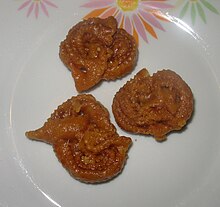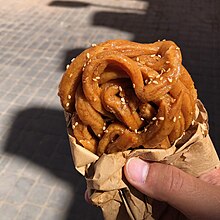 | |
| Type | Dessert |
|---|---|
| Place of origin | Ottoman Empire |
| Region or state | Maghreb |
| Main ingredients | dough, honey and orange blossom water |
Shebakia ( Arabic: شباكية) or Chebakia, also known as Griwech or Griouech, is a Maghrebi pastry made of strips of dough rolled to resemble a rose, deep-fried until golden, then coated with a syrup made of honey and orange blossom water and sprinkled with sesame. [1] [2] [3] It is typically consumed during Ramadan and religious celebrations. [1] [4] Chebakia is from the Ottoman desserts culture. [5]
Chebakia is made using yeast spiced with anise, cinnamon, and saffron. [6] The dough is made from ground sesame seeds mixed with flour and maybe squeezed through a pastry tube or twisted by hand to achieve the flower-like shape. [6] [7] It is then fried like a donut. The pastry is often produced in large batches at the start of Ramadan. [8] [6] Although it is sweet and is often paired with coffee and tea, Moroccans also eat chebakia with spicy food such as harira. [6]


Similar pastries include the Cartellate and the Fazuelos, though the latter are constructed differently, and are thinner, less dense and from different regions.
Names and origin
Etymology
The names of Chebbakia, and its size, shape and exact ingredient may vary by region. In Algeria [1] and in Fez, Morocco, it's known as griwech ( Moroccan Arabic: ڭريوش or Algerian Arabic: قريوش). In Rabat, as mkherqa (مخرقة). In Salé, as El-qli (القلي). In Ouezzane as lahlou (الحلو), and in some other Moroccan region as kliwech (كليوش). [9] [10]
History
The origin of this pastry is likely Ottoman, due to its similarity to Eastern pastries such as baklawa in former Ottoman areas, and meshbek in Syria also known as zalabiyeh. [11]
In Morocco, a folk origin story claims that chebbakia was invented by an ambulant pastry merchant, who fell in love with a beautiful girl he saw every day at her window, and decided to make honeyed pastries in the shape of her window ( Arabic: شباك, shubbak), to give her as a gift. [11]
See also
References
- ^ a b c Benayoun, Mike (1 Jul 2016). "Griouech". 196 flavors. Retrieved 13 Nov 2022.
- ^ Mom, LDS's (3 Sep 2018). "Algerian Crunchy Sweets- Griwech". My Excellent Degustations. Retrieved 13 Nov 2022.
- ^ "about.com". Archived from the original on 2017-02-08. Retrieved 2014-04-24.
- ^ "Moroccan Sesame and Honey Cookies With Saffron, Cinnamon and Anise". The Spruce Eats. Retrieved 2021-11-09.
- ^ Oktay, S. and Sadıkoglu, S., 2018. Journal of Ethnic Foods. p.6.
- ^ a b c d Sheen, Barbara (2011). Foods of Morocco. Farmington Hills, MI: Greenhaven Publishing LLC. p. 44. ISBN 978-0-7377-5865-8.
- ^ Newton, James (2012). Moroccan Cookbook - Moroc Cuisine. Springwood emedia. pp. 93–94. ISBN 978-1-4760-7547-1.
- ^ Lonely Planet's Ultimate Eats: The world's top 500 food experiences...ranked!. Lonely Planet Food. 2018. ISBN 978-1-78701-977-5.
- ^ "الشباكية". Retrieved 2023-07-01.
- ^ Benkabbou, Nargisse (2018). Casablanca: My Moroccan Food. Octopus. ISBN 9781784725105.
- ^ a b "أصولها عثمانية ووصلت إلى المغرب عن طريق الجزائر.. "الشباكية"، أشهر الحلويات الرمضانية المغربية" [Its origin is Ottoman and it arrived to Morocco through Algeria]. 2023-03-16. Retrieved 2023-07-01.
External links
- "Chebakia (Chebbakia, Halwa Shebakia, Mkharka) - Recipe for Fried Moroccan Sesame Cookies with Honey". About.com Moroccan Food. Archived from the original on 2017-02-08. Retrieved 2014-04-24.
- כהן, רפי (25 February 2010). "המתוקות הראשונות: משלוח מנות חגיגי". ynet. Retrieved 2014-04-24.
 | |
| Type | Dessert |
|---|---|
| Place of origin | Ottoman Empire |
| Region or state | Maghreb |
| Main ingredients | dough, honey and orange blossom water |
Shebakia ( Arabic: شباكية) or Chebakia, also known as Griwech or Griouech, is a Maghrebi pastry made of strips of dough rolled to resemble a rose, deep-fried until golden, then coated with a syrup made of honey and orange blossom water and sprinkled with sesame. [1] [2] [3] It is typically consumed during Ramadan and religious celebrations. [1] [4] Chebakia is from the Ottoman desserts culture. [5]
Chebakia is made using yeast spiced with anise, cinnamon, and saffron. [6] The dough is made from ground sesame seeds mixed with flour and maybe squeezed through a pastry tube or twisted by hand to achieve the flower-like shape. [6] [7] It is then fried like a donut. The pastry is often produced in large batches at the start of Ramadan. [8] [6] Although it is sweet and is often paired with coffee and tea, Moroccans also eat chebakia with spicy food such as harira. [6]


Similar pastries include the Cartellate and the Fazuelos, though the latter are constructed differently, and are thinner, less dense and from different regions.
Names and origin
Etymology
The names of Chebbakia, and its size, shape and exact ingredient may vary by region. In Algeria [1] and in Fez, Morocco, it's known as griwech ( Moroccan Arabic: ڭريوش or Algerian Arabic: قريوش). In Rabat, as mkherqa (مخرقة). In Salé, as El-qli (القلي). In Ouezzane as lahlou (الحلو), and in some other Moroccan region as kliwech (كليوش). [9] [10]
History
The origin of this pastry is likely Ottoman, due to its similarity to Eastern pastries such as baklawa in former Ottoman areas, and meshbek in Syria also known as zalabiyeh. [11]
In Morocco, a folk origin story claims that chebbakia was invented by an ambulant pastry merchant, who fell in love with a beautiful girl he saw every day at her window, and decided to make honeyed pastries in the shape of her window ( Arabic: شباك, shubbak), to give her as a gift. [11]
See also
References
- ^ a b c Benayoun, Mike (1 Jul 2016). "Griouech". 196 flavors. Retrieved 13 Nov 2022.
- ^ Mom, LDS's (3 Sep 2018). "Algerian Crunchy Sweets- Griwech". My Excellent Degustations. Retrieved 13 Nov 2022.
- ^ "about.com". Archived from the original on 2017-02-08. Retrieved 2014-04-24.
- ^ "Moroccan Sesame and Honey Cookies With Saffron, Cinnamon and Anise". The Spruce Eats. Retrieved 2021-11-09.
- ^ Oktay, S. and Sadıkoglu, S., 2018. Journal of Ethnic Foods. p.6.
- ^ a b c d Sheen, Barbara (2011). Foods of Morocco. Farmington Hills, MI: Greenhaven Publishing LLC. p. 44. ISBN 978-0-7377-5865-8.
- ^ Newton, James (2012). Moroccan Cookbook - Moroc Cuisine. Springwood emedia. pp. 93–94. ISBN 978-1-4760-7547-1.
- ^ Lonely Planet's Ultimate Eats: The world's top 500 food experiences...ranked!. Lonely Planet Food. 2018. ISBN 978-1-78701-977-5.
- ^ "الشباكية". Retrieved 2023-07-01.
- ^ Benkabbou, Nargisse (2018). Casablanca: My Moroccan Food. Octopus. ISBN 9781784725105.
- ^ a b "أصولها عثمانية ووصلت إلى المغرب عن طريق الجزائر.. "الشباكية"، أشهر الحلويات الرمضانية المغربية" [Its origin is Ottoman and it arrived to Morocco through Algeria]. 2023-03-16. Retrieved 2023-07-01.
External links
- "Chebakia (Chebbakia, Halwa Shebakia, Mkharka) - Recipe for Fried Moroccan Sesame Cookies with Honey". About.com Moroccan Food. Archived from the original on 2017-02-08. Retrieved 2014-04-24.
- כהן, רפי (25 February 2010). "המתוקות הראשונות: משלוח מנות חגיגי". ynet. Retrieved 2014-04-24.
